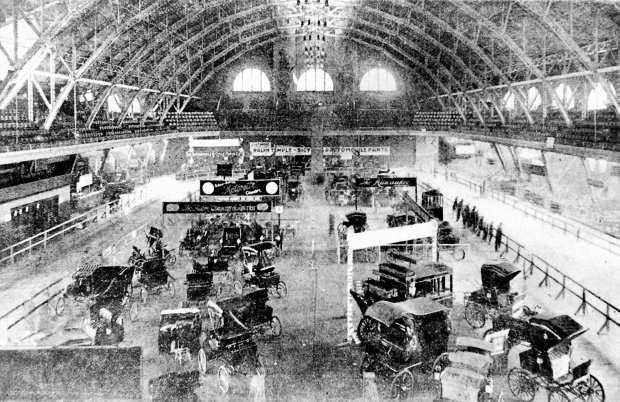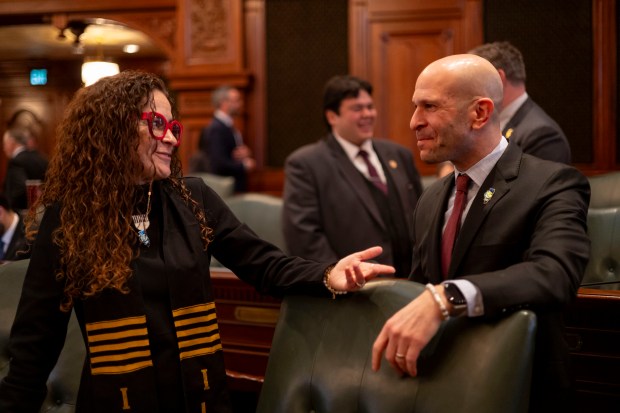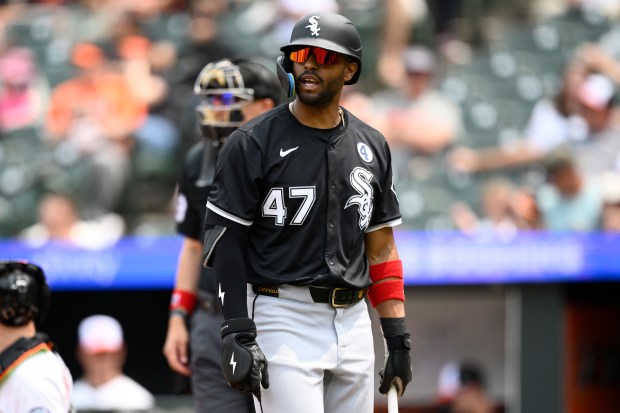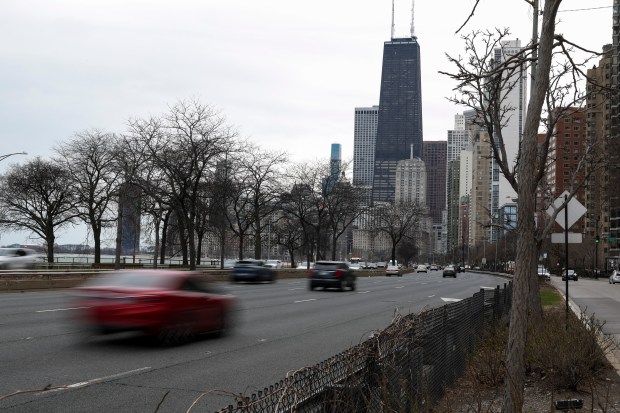For the 117th time, The Chicago Auto Show will park a variety of concept, crossover and customary vehicles at McCormick Place. We took a look through the Tribune archives for highlights from several editions but need only look across the newsroom for someone who considers the annual event a must-see — Tribune business reporter Robert Channick. We are grateful to him for sharing one of his favorite memories:
Launched in 1901, the Chicago Auto Show is one of the largest in the U.S., with a history that dates back to the beginning of the automobile industry. With the 117th edition ready to open Saturday, my own experience with the show spans almost half that history.
While I have been covering the annual show for the Tribune for the past 15 years, I attended my first Chicago Auto Show nearly 60 years ago, tagging along on an outing with a friend’s family.
Growing up during the ’60s, my friends and I were fascinated with cars — especially the souped-up muscle cars coming out of Detroit. Even the now-defunct AMC managed to jam a massive 390 V8 inside a Rambler — the boxiest, most sedate-looking sedan ever built — creating a red-white-and-blue beast, a photo of which ended up plastered on my bedroom wall.
Piling in a station wagon, we headed to the auto show, which had been temporarily moved back to the since-demolished International Amphitheatre after a 1967 fire destroyed McCormick Place, the city’s relatively new convention center. A rebuilt McCormick Place would welcome back the auto show in 1971.
My memories of that weekend afternoon from the late 1960s are a bit fuzzy. There were new cars and mini-skirted models spinning on carousels, large crowds migrating from display-to-display to kick the whitewall tires and air that was probably thick with cigarette smoke.
It was wonderful.
But the enduring memory was a bit of good fortune at the culmination of our visit. I had entered a drawing, perhaps hoping to win a new car, which I planned to store in my garage for the five years or so until I could drive. Then someone pulled a slip out of the box and announced my name over the PA system. The prize was a small brown radio, a sort of pre-boom box with a handle that only had AM and a tinny speaker.
It wasn’t a car, but I was thrilled.
On the drive home, clutching the radio, my head filled with the sights, sounds and smells of an auditorium of new cars, I felt like the luckiest kid in Chicago.
March 23-31, 1901
The exhibition of automobiles — commonly called “horseless carriages” at the time — was the first indoor exhibition of its kind held in Chicago. The Coliseum hosted the event, which was sanctioned by the National Association of Automobile Manufacturers and included vehicles displayed by 65 firms from around the United States.
According to the Tribune, it was the “first show of this character held in the West.” One of the most popular features was the track, shown in the photo above, which hosted an obstacle race and a flower parade. And only one person reported being run over at the show.
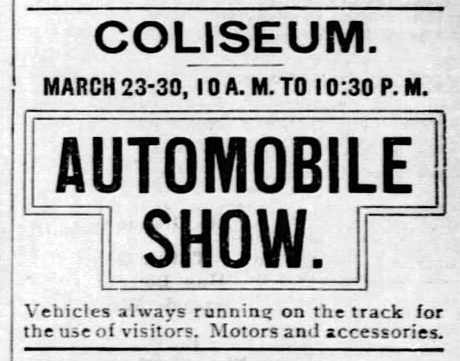
“Every visitor who wished to do so could ride on one of the numerous automobiles exhibited,” the Tribune reported. “The autoomnibuses carried large crowds of people, and all day until the closing hour there was a continuous string of automobiles of every description racing around the drive.”
An “A Line O’ Type or Two” column from 1961 said there were calls of “Get a horse” each time one of the autos made an unscheduled stop during that first exhibition.
The nine-day show hosted almost 30,000 visitors, and one company reported sales of $50,000 (or more than $1 million in today’s dollars) worth of vehicles.
“The result of the exhibition has been to place the affair on a solid foundation and assure to the people of Chicago the annual recurrence of the show,” Samuel A. Miles, show manager, told the Tribune.
Jan. 27-Feb. 3, 1917
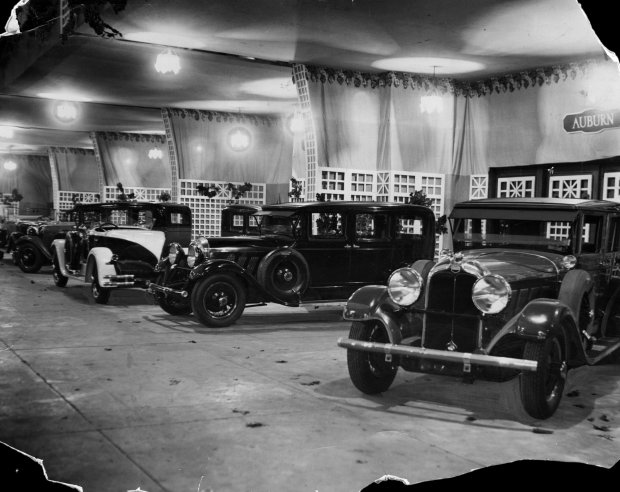
About 40,000 people attended the first day of the 17th annual car show and 280,000 people visited the Coliseum during the weeklong event. High-end vehicles were displayed in a ballroom at the Congress Plaza Hotel, but one vehicle stood out from the rest — Studebaker’s 24-carat gold-plated New Series 18.
Valued at $30,000 (or $800,000 in today’s dollars), the auto with white enamel interior was placed atop a mirror plate so its chassis construction could be displayed.
Nov. 16-23, 1935
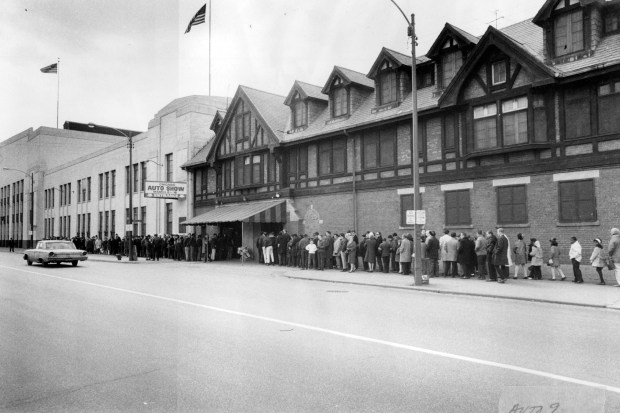
The 36th annual auto show had a new location inside the International Amphitheatre and a new sponsor — the Chicago Automobile Trade Association. The recently completed facility provided four times the floor space of the Coliseum, making Chicago the largest automobile show in the world at the time. The event continued to be held at the venue until 1960, then returned there in the late 1960s.
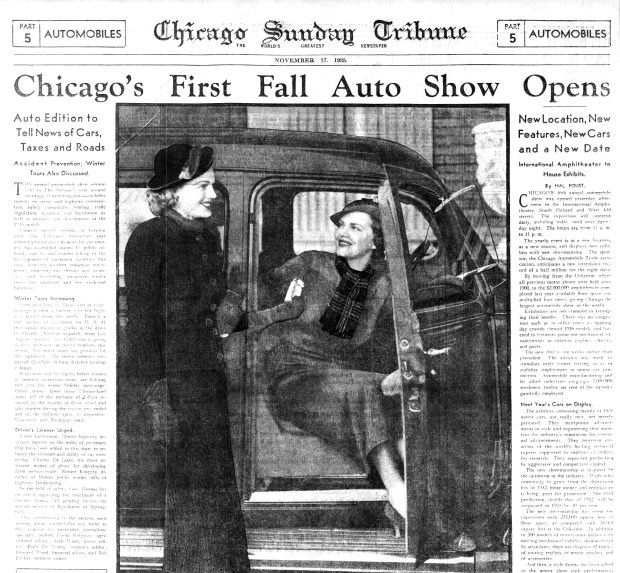
The show was held in the late fall — nearly 10 weeks earlier than usual — to “stimulate early winter buying so as to stabilize employment in motor car production,” the Tribune reported.
Just one year later, a pageantry of “pretty girls” entitled “Brides of the Nations” featured 21 women from a variety of the city’s ethnic groups posing as mannequins alongside the new vehicles. A pageant continued yearly in coordination with the auto show into the 1950s.
Feb. 18-26, 1950
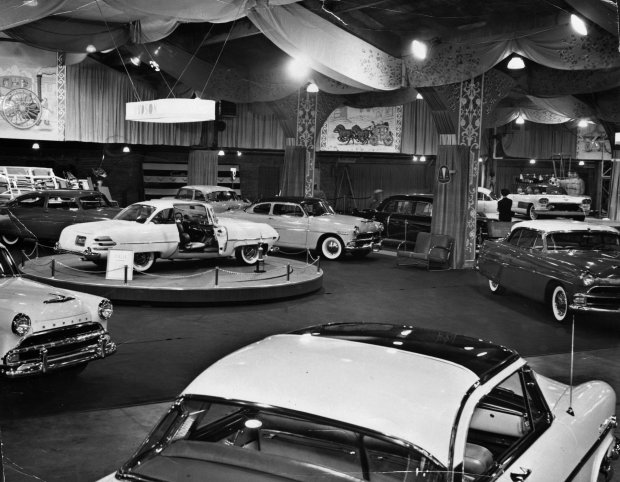
After 1940, the Chicago Auto Show broke for World War II. It returned in 1950, becoming the first post-war auto show in the U.S. Nearly 300 passenger cars and trucks were displayed. The highlight included a Cadillac trimmed in leopard skin and with gold-plated fittings, valued at more than $35,000 (or $470,000 in today’s dollars).
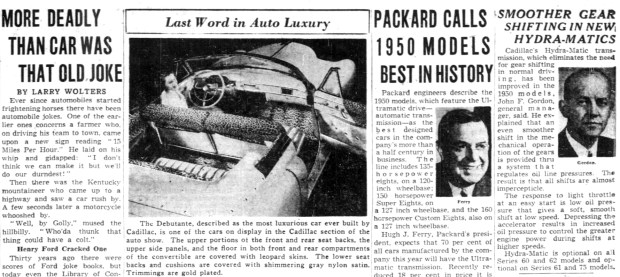
A stage spectacle, “Wheels of Freedom,” highlighted “patriotic pageantry, music, and pretty girls,” the Tribune reported. Twenty-four-feet-tall painted portraits of George Washington and Abraham Lincoln — said to be the largest ever of the two presidents — served as a backdrop.
The approximately 365,000 visitors also were welcomed by models of cloverleaf interchanges designed for the new Congress Parkway (later renamed the Eisenhower Expressway).
March 13-31, 1954
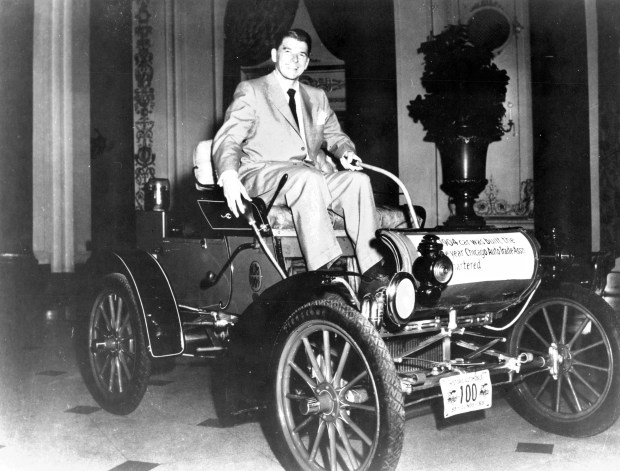
Illinois-born television actor and future U.S. president Ronald Reagan was the show’s grand marshal. He also appeared on the WMAQ-FM radio broadcast of “The Northerners” live from The Palmer House to celebrate the 50th anniversary of the Chicago Automobile Trade Association.
Feb. 18-26, 1961
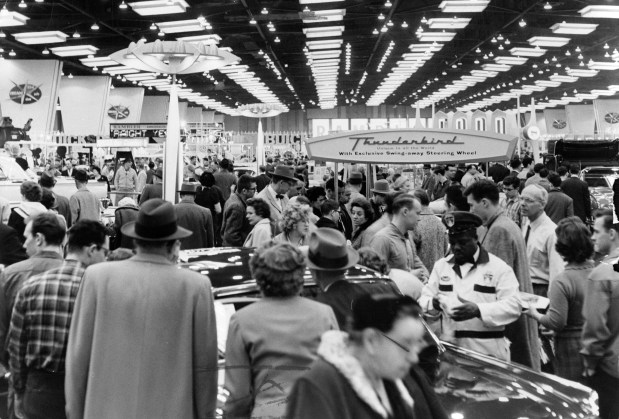
The event moved to the new McCormick Place with 300,000 square feet of exhibit space and more than 400 cars on display. Almost 80,000 people showed up the first day and almost 790,000 during the nine-day run — both new records for the show.
For the first time, all cars, trucks and exhibits could be displayed on the same floor in “one vast, colorful arena,” the Tribune reported. New that year was an import car salon in the lower-level lobby of McCormick Place, with 30 vehicles by 18 exhibitors. The first event staged in McCormick Place’s 5,086-seat theater was “Motorevue of 1961.”
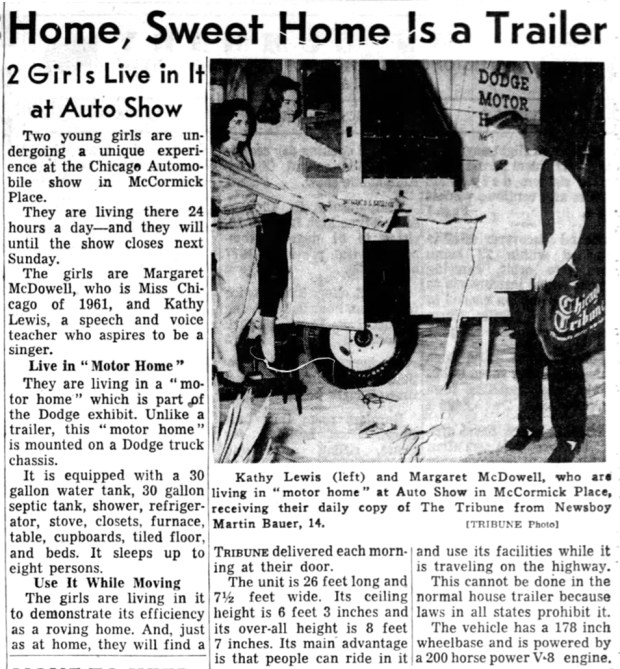
Miss Chicago 1961 Margaret McDowell and Kathy Lewis lived inside a Dodge motor home throughout the show to demonstrate its efficiency and usefulness as a roving home.
The auto show would remain at McCormick Place until the facility was destroyed by a fire on Jan. 16, 1967. It returned to the International Amphitheatre until 1971.
Feb. 26-March 5, 1972
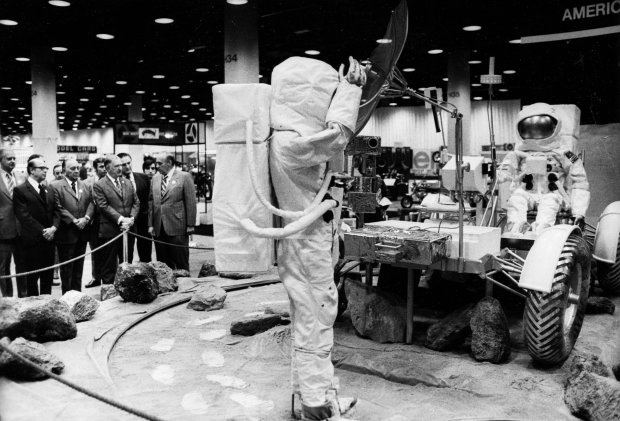
Among the Continentals, Pintos, Suburbans and Galaxies seen by almost 1 million visitors was a vehicle from another planet — a moon buggy.
A full-scale mock-up of the first lunar rover from the Apollo 15 mission, constructed by NASA, was displayed in a setting that simulated the moon. The 10-foot-long car included two mannequin-version of astronauts David Scott and James Irwin.
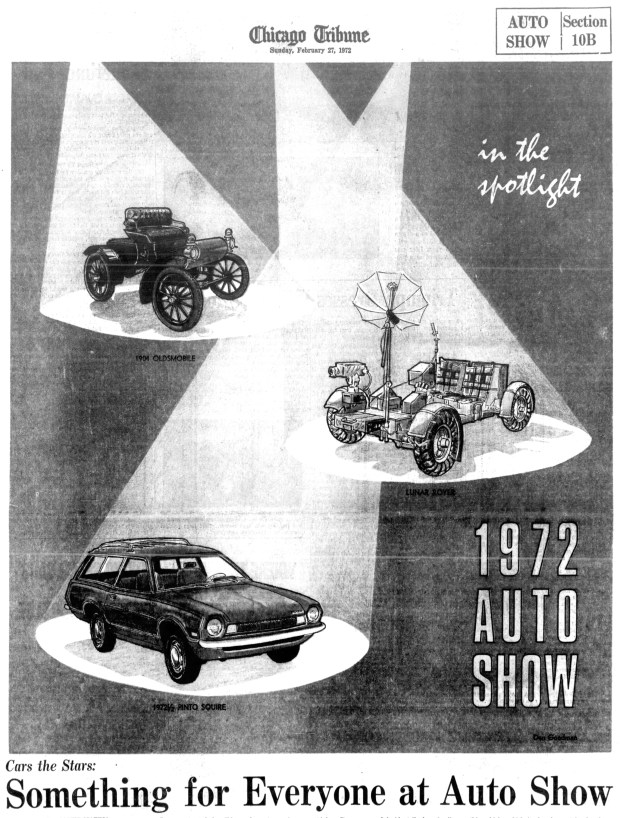
The original lunar rover cost $12.7 million to build (or about $20 million in today’s dollars), had a top speed of 8 mph and was powered by two batteries and an electric motor for each of its four wheels. But it wouldn’t make it to any auto shows on Earth — the vehicle was left on the moon after it was driven 22 miles to take geological samples.
Feb. 8-16, 1986
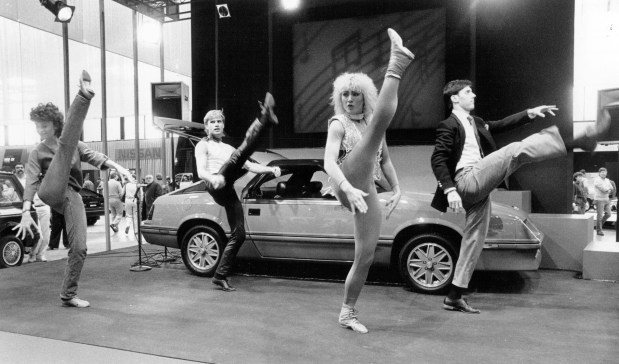
“Fiero, Ferrari and even the Fridge,” the Tribune wrote in 1986. The names of the celebrities who appeared at the 78th edition were just as vibrant as the vehicles.
Chicago Bears player William “Refrigerator” Perry was at the Pontiac display; Walter Payton was by the Buicks; and members of the Bears’ offensive line stopped at Chevrolet, where Chicago Bulls Hall-of-Famer Michael Jordan and Chicago Cubs second baseman Ryne Sandberg also appeared. Dodge highlighted talk show host and “The Color Purple” actress Oprah Winfrey.
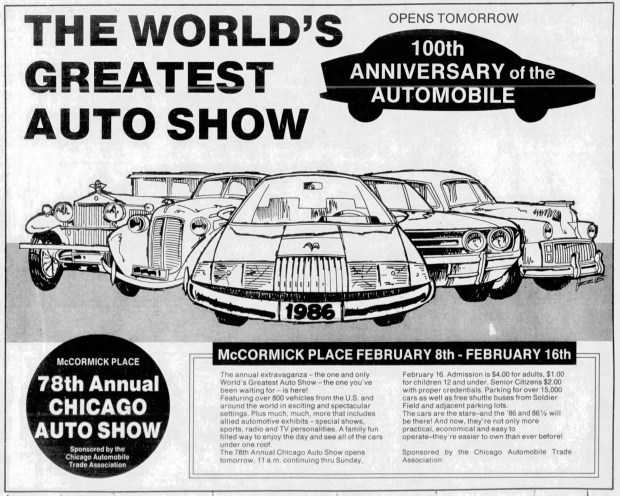
Newly shown autos included Chevrolet’s Corvette convertible, Toyota’s redesigned Supra, the $3,990 Yugo mini car from Yugoslavia and a mini Excel from Hyundai of South Korea, that nation’s first entry into the U.S. market.
Want more vintage Chicago?
- Become a Tribune subscriber: It’s just $12 for a 1-year digital subscription
Thanks for reading!
Subscribe to the free Vintage Chicago Tribune newsletter, join our Chicagoland history Facebook group, stay current with Today in Chicago History and follow us on Instagram for more from Chicago’s past.
Have an idea for Vintage Chicago Tribune? Share it with Kori Rumore and Marianne Mather at krumore@chicagotribune.com and mmather@chicagotribune.com


